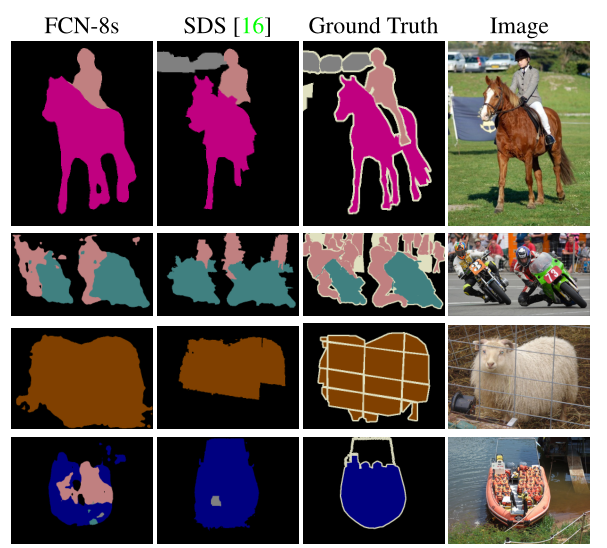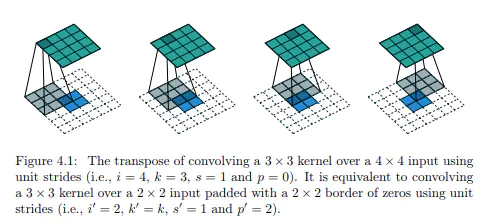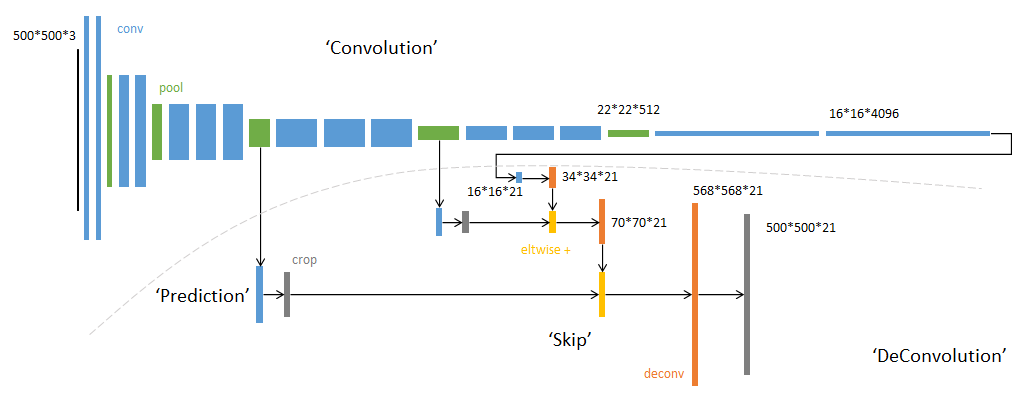昇思25天学习打卡营第11天 | FCN图像语义分割
文章目录
语义分割(semantic segmentation) 常被用于人脸识别、物体检测、医学影像、卫星图像分析、自动驾驶等领域。
语义分割的目的是对图像中的每一个像素进行分类,输出与输入图像大小相同的图像,每个像素代表对应输入像素所属的类别。

FCN模型
全卷积神经网络(Fully Convolutional Networks,FCN)是一种端到端的分割方法,通过进行像素级的预测直接得出与原图大小相等的label map。
FCN主要使用以下三种技术:
- 卷积化: 使用VGG-16作为FCN的backbone。

- 上采样: :通过反卷积对特征图进行上采样,以恢复输入图像的分辨率。

- 跳跃结构: 由于最后一层特征图太小,损失过多细节,采用skips结构将更具全局信息的最后一层和更浅层的预测结合,使预测结果获得更多的局部细节。

数据处理
下载数据集
from download import download
url = "https://mindspore-website.obs.cn-north-4.myhuaweicloud.com/notebook/datasets/dataset_fcn8s.tar"
download(url, "./dataset", kind="tar", replace=True)
创建训练集
import cv2
import mindspore.dataset as ds
import numpy as np
class SegDataset:
def __init__(
self,
image_mean,
image_std,
data_file="",
batch_size=32,
crop_size=512,
max_scale=2.0,
min_scale=0.5,
ignore_label=255,
num_classes=21,
num_readers=2,
num_parallel_calls=4,
):
self.data_file = data_file
self.batch_size = batch_size
self.crop_size = crop_size
self.image_mean = np.array(image_mean, dtype=np.float32)
self.image_std = np.array(image_std, dtype=np.float32)
self.max_scale = max_scale
self.min_scale = min_scale
self.ignore_label = ignore_label
self.num_classes = num_classes
self.num_readers = num_readers
self.num_parallel_calls = num_parallel_calls
max_scale > min_scale
def preprocess_dataset(self, image, label):
image_out = cv2.imdecode(np.frombuffer(image, dtype=np.uint8), cv2.IMREAD_COLOR)
label_out = cv2.imdecode(
np.frombuffer(label, dtype=np.uint8), cv2.IMREAD_GRAYSCALE
)
sc = np.random.uniform(self.min_scale, self.max_scale) # 随机缩放
new_h, new_w = int(sc * image_out.shape[0]), int(sc * image_out.shape[1])
image_out = cv2.resize(image_out, (new_w, new_h), interpolation=cv2.INTER_CUBIC)
label_out = cv2.resize(
label_out, (new_w, new_h), interpolation=cv2.INTER_NEAREST
)
image_out = (image_out - self.image_mean) / self.image_std
out_h, out_w = max(new_h, self.crop_size), max(new_w, self.crop_size)
pad_h, pad_w = out_h - new_h, out_w - new_w
if pad_h > 0 or pad_w > 0:
image_out = cv2.copyMakeBorder(
image_out, 0, pad_h, 0, pad_w, cv2.BORDER_CONSTANT, value=0
)
label_out = cv2.copyMakeBorder(
label_out,
0,
pad_h,
0,
pad_w,
cv2.BORDER_CONSTANT,
value=self.ignore_label,
)
offset_h = np.random.randint(0, out_h - self.crop_size + 1)
offset_w = np.random.randint(0, out_w - self.crop_size + 1)
image_out = image_out[
offset_h : offset_h + self.crop_size,
offset_w : offset_w + self.crop_size,
:,
]
label_out = label_out[
offset_h : offset_h + self.crop_size, offset_w : offset_w + self.crop_size
]
if np.random.uniform(0.0, 1.0) > 0.5:
image_out = image_out[:, ::-1, :]
label_out = label_out[:, ::-1]
image_out = image_out.transpose((2, 0, 1))
image_out = image_out.copy()
label_out = label_out.copy()
label_out = label_out.astype("int32")
return image_out, label_out
def get_dataset(self):
ds.config.set_numa_enable(True)
dataset = ds.MindDataset(
self.data_file,
columns_list=["data", "label"],
shuffle=True,
num_parallel_workers=self.num_readers,
)
transforms_list = self.preprocess_dataset
dataset = dataset.map(
operations=transforms_list,
input_columns=["data", "label"],
output_columns=["data", "label"],
num_parallel_workers=self.num_parallel_calls,
)
dataset = dataset.shuffle(buffer_size=self.batch_size * 10)
dataset = dataset.batch(self.batch_size, drop_remainder=True)
return dataset
# 定义创建数据集的参数
IMAGE_MEAN = [103.53, 116.28, 123.675]
IMAGE_STD = [57.375, 57.120, 58.395]
DATA_FILE = "dataset/dataset_fcn8s/mindname.mindrecord"
# 定义模型训练参数
train_batch_size = 4
crop_size = 512
min_scale = 0.5
max_scale = 2.0
ignore_label = 255
num_classes = 21
# 实例化Dataset
dataset = SegDataset(
image_mean=IMAGE_MEAN,
image_std=IMAGE_STD,
data_file=DATA_FILE,
batch_size=train_batch_size,
crop_size=crop_size,
max_scale=max_scale,
min_scale=min_scale,
ignore_label=ignore_label,
num_classes=num_classes,
num_readers=2,
num_parallel_calls=4,
)
dataset = dataset.get_dataset()
在上面的类SegDataset中:
__init__()里初始化了一些参数preprocess_dataset()定义了对输入图像的大量变换,包括:- 对图像和标签随机缩放;
- 图像归一化;
- 填充或裁剪图片为
crop_size × crop_size大小; - 随机水平翻转;
- 将<H,W,C>图像转换为<C,H,W>;
- 将标签数据转换为
int32类型。
get_dataset()中定义了数据集和数据变换,设置了并行。
可视化训练集
import matplotlib.pyplot as plt
import numpy as np
plt.figure(figsize=(16, 8))
# 对训练集中的数据进行展示
for i in range(1, 9):
plt.subplot(2, 4, i)
show_data = next(dataset.create_dict_iterator())
show_images = show_data["data"].asnumpy()
show_images = np.clip(show_images, 0, 1)
# 将图片转换HWC格式后进行展示
plt.imshow(show_images[0].transpose(1, 2, 0))
plt.axis("off")
plt.subplots_adjust(wspace=0.05, hspace=0)
plt.show()
网络构建

网络结构
- 第一个卷积块:输入
512
×
512
×
3
512\times512\times3
512×512×3图像,每一个卷积操作后面紧跟一个
nn.BatchNorm2d(out_channels)和nn.ReLU()
self.conv1 = nn.SequentialCell(
nn.Conv2d(
in_channels=3,
out_channels=64,
kernel_size=3,
weight_init="xavier_uniform",
),
nn.BatchNorm2d(64),
nn.ReLU(),
nn.Conv2d(
in_channels=64,
out_channels=64,
kernel_size=3,
weight_init="xavier_uniform",
),
nn.BatchNorm2d(64),
nn.ReLU(),
)
- 第一个池化:最大池化(Max Pooling),输入图像尺寸变为原始图像 1 / 2 1/2 1/2。
self.pool1 = nn.MaxPool2d(kernel_size=2, stride=2)
- 第二个卷积块:
self.conv2 = nn.SequentialCell(
nn.Conv2d(
in_channels=64,
out_channels=128,
kernel_size=3,
weight_init="xavier_uniform",
),
nn.BatchNorm2d(128),
nn.ReLU(),
nn.Conv2d(
in_channels=128,
out_channels=128,
kernel_size=3,
weight_init="xavier_uniform",
),
nn.BatchNorm2d(128),
nn.ReLU(),
)
- 第二个池化:变为原始图像 1 / 4 1/4 1/4
self.pool2 = nn.MaxPool2d(kernel_size=2, stride=2)
- 第三个卷积快:
self.conv3 = nn.SequentialCell(
nn.Conv2d(
in_channels=128,
out_channels=256,
kernel_size=3,
weight_init="xavier_uniform",
),
nn.BatchNorm2d(256),
nn.ReLU(),
nn.Conv2d(
in_channels=256,
out_channels=256,
kernel_size=3,
weight_init="xavier_uniform",
),
nn.BatchNorm2d(256),
nn.ReLU(),
nn.Conv2d(
in_channels=256,
out_channels=256,
kernel_size=3,
weight_init="xavier_uniform",
),
nn.BatchNorm2d(256),
nn.ReLU(),
)
- 第三个池化:变为原始图像 1 / 8 1/8 1/8
self.pool3 = nn.MaxPool2d(kernel_size=2, stride=2)
- 第四个卷积块:
self.conv4 = nn.SequentialCell(
nn.Conv2d(
in_channels=256,
out_channels=512,
kernel_size=3,
weight_init="xavier_uniform",
),
nn.BatchNorm2d(512),
nn.ReLU(),
nn.Conv2d(
in_channels=512,
out_channels=512,
kernel_size=3,
weight_init="xavier_uniform",
),
nn.BatchNorm2d(512),
nn.ReLU(),
nn.Conv2d(
in_channels=512,
out_channels=512,
kernel_size=3,
weight_init="xavier_uniform",
),
nn.BatchNorm2d(512),
nn.ReLU(),
)
- 第四个池化:变为原始图像 1 / 16 1/16 1/16
self.pool4 = nn.MaxPool2d(kernel_size=2, stride=2)
- 第五个卷积块:
self.conv5 = nn.SequentialCell(
nn.Conv2d(
in_channels=512,
out_channels=512,
kernel_size=3,
weight_init="xavier_uniform",
),
nn.BatchNorm2d(512),
nn.ReLU(),
nn.Conv2d(
in_channels=512,
out_channels=512,
kernel_size=3,
weight_init="xavier_uniform",
),
nn.BatchNorm2d(512),
nn.ReLU(),
nn.Conv2d(
in_channels=512,
out_channels=512,
kernel_size=3,
weight_init="xavier_uniform",
),
nn.BatchNorm2d(512),
nn.ReLU(),
)
- 第五个池化:变为原始图像 1 / 32 1/32 1/32
self.pool5 = nn.MaxPool2d(kernel_size=2, stride=2)
- 第六、七个卷积块:保持图像大小不变,替换全连接层
self.conv6 = nn.SequentialCell(
nn.Conv2d(
in_channels=512,
out_channels=4096,
kernel_size=7,
weight_init="xavier_uniform",
),
nn.BatchNorm2d(4096),
nn.ReLU(),
)
self.conv7 = nn.SequentialCell(
nn.Conv2d(
in_channels=4096,
out_channels=4096,
kernel_size=1,
weight_init="xavier_uniform",
),
nn.BatchNorm2d(4096),
nn.ReLU(),
)
self.score_fr = nn.Conv2d(in_channels=4096, out_channels=self.n_class,
kernel_size=1, weight_init='xavier_uniform')
- 反卷积层:
self.upscore2 = nn.Conv2dTranspose(
in_channels=self.n_class,
out_channels=self.n_class,
kernel_size=4,
stride=2,
weight_init="xavier_uniform",
)
self.score_pool4 = nn.Conv2d(
in_channels=512,
out_channels=self.n_class,
kernel_size=1,
weight_init="xavier_uniform",
)
self.upscore_pool4 = nn.Conv2dTranspose(
in_channels=self.n_class,
out_channels=self.n_class,
kernel_size=4,
stride=2,
weight_init="xavier_uniform",
)
self.score_pool3 = nn.Conv2d(
in_channels=256,
out_channels=self.n_class,
kernel_size=1,
weight_init="xavier_uniform",
)
self.upscore8 = nn.Conv2dTranspose(
in_channels=self.n_class,
out_channels=self.n_class,
kernel_size=16,
stride=8,
weight_init="xavier_uniform",
)
张量操作
def construct(self, x):
x1 = self.conv1(x)
p1 = self.pool1(x1)
x2 = self.conv2(p1)
p2 = self.pool2(x2)
x3 = self.conv3(p2)
p3 = self.pool3(x3)
x4 = self.conv4(p3)
p4 = self.pool4(x4)
x5 = self.conv5(p4)
p5 = self.pool5(x5)
x6 = self.conv6(p5)
x7 = self.conv7(x6)
sf = self.score_fr(x7)
u2 = self.upscore2(sf)
s4 = self.score_pool4(p4)
f4 = s4 + u2
u4 = self.upscore_pool4(f4)
s3 = self.score_pool3(p3)
f3 = s3 + u4
out = self.upscore8(f3)
return out
训练准备
导入VGG-16部分预训练权重:
from download import download
from mindspore import load_checkpoint, load_param_into_net
url = "https://mindspore-website.obs.cn-north-4.myhuaweicloud.com/notebook/datasets/fcn8s_vgg16_pretrain.ckpt"
download(url, "fcn8s_vgg16_pretrain.ckpt", replace=True)
def load_vgg16():
ckpt_vgg16 = "fcn8s_vgg16_pretrain.ckpt"
param_vgg = load_checkpoint(ckpt_vgg16)
load_param_into_net(net, param_vgg)
损失函数
语义分割是对图像中像素点进行分类,仍然属于分类问题,故使用交叉熵损失函数nn.CrossEntropyLoss()。
模型评估指标
用来评估训练出来的模型好坏。
- Pixel Accuracy(PA, 像素精度):标记真确的像素占总像素的比例:
P A = ∑ i = 0 k p i i ∑ i = 0 k ∑ j = 0 k p i j PA = \frac{\sum_{i=0}^kp_{ii}}{\sum_{i=0}^k\sum_{j=0}^kp_{ij}} PA=∑i=0k∑j=0kpij∑i=0kpii
import mindspore as ms
import mindspore.nn as nn
import mindspore.train as train
import numpy as np
class PixelAccuracy(train.Metric):
def __init__(self, num_class=21):
super(PixelAccuracy, self).__init__()
self.num_class = num_class
def _generate_matrix(self, gt_image, pre_image):
mask = (gt_image >= 0) & (gt_image < self.num_class)
label = self.num_class * gt_image[mask].astype("int") + pre_image[mask]
count = np.bincount(label, minlength=self.num_class**2)
confusion_matrix = count.reshape(self.num_class, self.num_class)
return confusion_matrix
def clear(self):
self.confusion_matrix = np.zeros((self.num_class,) * 2)
def update(self, *inputs):
y_pred = inputs[0].asnumpy().argmax(axis=1)
y = inputs[1].asnumpy().reshape(4, 512, 512)
self.confusion_matrix += self._generate_matrix(y, y_pred)
def eval(self):
pixel_accuracy = (
np.diag(self.confusion_matrix).sum() / self.confusion_matrix.sum()
)
return pixel_accuracy
- Mean Pixel Accuracy(MPA,均像素精度):计算每个类内正确分类的像素比例,然后求平均:
M P A = 1 k + 1 ∑ i = 0 k p i i ∑ j = 0 k p i j MPA = \frac1{k+1}\sum_{i=0}^k\frac{p_{ii}}{\sum_{j=0}^kp_{ij}} MPA=k+11i=0∑k∑j=0kpijpii
class PixelAccuracyClass(train.Metric):
def __init__(self, num_class=21):
super(PixelAccuracyClass, self).__init__()
self.num_class = num_class
def _generate_matrix(self, gt_image, pre_image):
mask = (gt_image >= 0) & (gt_image < self.num_class)
label = self.num_class * gt_image[mask].astype("int") + pre_image[mask]
count = np.bincount(label, minlength=self.num_class**2)
confusion_matrix = count.reshape(self.num_class, self.num_class)
return confusion_matrix
def update(self, *inputs):
y_pred = inputs[0].asnumpy().argmax(axis=1)
y = inputs[1].asnumpy().reshape(4, 512, 512)
self.confusion_matrix += self._generate_matrix(y, y_pred)
def clear(self):
self.confusion_matrix = np.zeros((self.num_class,) * 2)
def eval(self):
mean_pixel_accuracy = np.diag(
self.confusion_matrix
) / self.confusion_matrix.sum(axis=1)
mean_pixel_accuracy = np.nanmean(mean_pixel_accuracy)
return mean_pixel_accuracy
- Mean Intersction over Union(MIoU,均交并比):两个集合(真实值和预测值)的交集和并集的比值。
M I o U = 1 k + 1 ∑ i = 0 k p i i ∑ j = 0 k p i j + ∑ j = 0 k p j i − p i i MIoU=\frac1{k+1}\sum_{i=0}^k\frac{p_{ii}}{\sum_{j=0}^kp_{ij}+\sum_{j=0}^kp_{ji}-p_{ii}} MIoU=k+11i=0∑k∑j=0kpij+∑j=0kpji−piipii
class MeanIntersectionOverUnion(train.Metric):
def __init__(self, num_class=21):
super(MeanIntersectionOverUnion, self).__init__()
self.num_class = num_class
def _generate_matrix(self, gt_image, pre_image):
mask = (gt_image >= 0) & (gt_image < self.num_class)
label = self.num_class * gt_image[mask].astype("int") + pre_image[mask]
count = np.bincount(label, minlength=self.num_class**2)
confusion_matrix = count.reshape(self.num_class, self.num_class)
return confusion_matrix
def update(self, *inputs):
y_pred = inputs[0].asnumpy().argmax(axis=1)
y = inputs[1].asnumpy().reshape(4, 512, 512)
self.confusion_matrix += self._generate_matrix(y, y_pred)
def clear(self):
self.confusion_matrix = np.zeros((self.num_class,) * 2)
def eval(self):
mean_iou = np.diag(self.confusion_matrix) / (
np.sum(self.confusion_matrix, axis=1)
+ np.sum(self.confusion_matrix, axis=0)
- np.diag(self.confusion_matrix)
)
mean_iou = np.nanmean(mean_iou)
return mean_iou
- Frequency Weighted Intersection over Union(FWIoU,频权交并比):根据每个类别出现的频率为MIoU设置权重
F W I o U = 1 ∑ i = 0 k ∑ j = 0 k p i j ∑ i = 0 k p i i ∑ j = 0 k p i j + ∑ j = 0 k p j i − p i i FWIoU=\frac1{\sum_{i=0}^k\sum_{j=0}^kp_{ij}}\sum_{i=0}^k\frac{p_{ii}}{\sum_{j=0}^kp_{ij}+\sum_{j=0}^kp_{ji}-p_{ii}} FWIoU=∑i=0k∑j=0kpij1i=0∑k∑j=0kpij+∑j=0kpji−piipii
class FrequencyWeightedIntersectionOverUnion(train.Metric):
def __init__(self, num_class=21):
super(FrequencyWeightedIntersectionOverUnion, self).__init__()
self.num_class = num_class
def _generate_matrix(self, gt_image, pre_image):
mask = (gt_image >= 0) & (gt_image < self.num_class)
label = self.num_class * gt_image[mask].astype("int") + pre_image[mask]
count = np.bincount(label, minlength=self.num_class**2)
confusion_matrix = count.reshape(self.num_class, self.num_class)
return confusion_matrix
def update(self, *inputs):
y_pred = inputs[0].asnumpy().argmax(axis=1)
y = inputs[1].asnumpy().reshape(4, 512, 512)
self.confusion_matrix += self._generate_matrix(y, y_pred)
def clear(self):
self.confusion_matrix = np.zeros((self.num_class,) * 2)
def eval(self):
freq = np.sum(self.confusion_matrix, axis=1) / np.sum(self.confusion_matrix)
iu = np.diag(self.confusion_matrix) / (
np.sum(self.confusion_matrix, axis=1)
+ np.sum(self.confusion_matrix, axis=0)
- np.diag(self.confusion_matrix)
)
frequency_weighted_iou = (freq[freq > 0] * iu[freq > 0]).sum()
return frequency_weighted_iou
模型训练
导入VGG-16预训练参数,定义超参数,实例化损失函数、优化器,使用Model接口编译网络,然后开始训练:
import mindspore
import mindspore.nn as nn
from mindspore import Tensor
from mindspore.train import (
CheckpointConfig,
LossMonitor,
Model,
ModelCheckpoint,
TimeMonitor,
)
device_target = "Ascend"
mindspore.set_context(mode=mindspore.PYNATIVE_MODE, device_target=device_target)
train_batch_size = 4
num_classes = 21
# 初始化模型结构
net = FCN8s(n_class=21)
# 导入vgg16预训练参数
load_vgg16()
# 计算学习率
min_lr = 0.0005
base_lr = 0.05
train_epochs = 1
iters_per_epoch = dataset.get_dataset_size()
total_step = iters_per_epoch * train_epochs
lr_scheduler = mindspore.nn.cosine_decay_lr(
min_lr, base_lr, total_step, iters_per_epoch, decay_epoch=2
)
lr = Tensor(lr_scheduler[-1])
# 定义损失函数
loss = nn.CrossEntropyLoss(ignore_index=255)
# 定义优化器
optimizer = nn.Momentum(
params=net.trainable_params(), learning_rate=lr, momentum=0.9, weight_decay=0.0001
)
# 定义loss_scale
scale_factor = 4
scale_window = 3000
loss_scale_manager = ms.amp.DynamicLossScaleManager(scale_factor, scale_window)
# 初始化模型
if device_target == "Ascend":
model = Model(
net,
loss_fn=loss,
optimizer=optimizer,
loss_scale_manager=loss_scale_manager,
metrics={
"pixel accuracy": PixelAccuracy(),
"mean pixel accuracy": PixelAccuracyClass(),
"mean IoU": MeanIntersectionOverUnion(),
"frequency weighted IoU": FrequencyWeightedIntersectionOverUnion(),
},
)
else:
model = Model(
net,
loss_fn=loss,
optimizer=optimizer,
metrics={
"pixel accuracy": PixelAccuracy(),
"mean pixel accuracy": PixelAccuracyClass(),
"mean IoU": MeanIntersectionOverUnion(),
"frequency weighted IoU": FrequencyWeightedIntersectionOverUnion(),
},
)
# 设置ckpt文件保存的参数
time_callback = TimeMonitor(data_size=iters_per_epoch)
loss_callback = LossMonitor()
callbacks = [time_callback, loss_callback]
save_steps = 330
keep_checkpoint_max = 5
config_ckpt = CheckpointConfig(
save_checkpoint_steps=10, keep_checkpoint_max=keep_checkpoint_max
)
ckpt_callback = ModelCheckpoint(prefix="FCN8s", directory="./ckpt", config=config_ckpt)
callbacks.append(ckpt_callback)
model.train(train_epochs, dataset, callbacks=callbacks)
模型评估
IMAGE_MEAN = [103.53, 116.28, 123.675]
IMAGE_STD = [57.375, 57.120, 58.395]
DATA_FILE = "dataset/dataset_fcn8s/mindname.mindrecord"
# 下载已训练好的权重文件
url = "https://mindspore-website.obs.cn-north-4.myhuaweicloud.com/notebook/datasets/FCN8s.ckpt"
download(url, "FCN8s.ckpt", replace=True)
net = FCN8s(n_class=num_classes)
ckpt_file = "FCN8s.ckpt"
param_dict = load_checkpoint(ckpt_file)
load_param_into_net(net, param_dict)
if device_target == "Ascend":
model = Model(
net,
loss_fn=loss,
optimizer=optimizer,
loss_scale_manager=loss_scale_manager,
metrics={
"pixel accuracy": PixelAccuracy(),
"mean pixel accuracy": PixelAccuracyClass(),
"mean IoU": MeanIntersectionOverUnion(),
"frequency weighted IoU": FrequencyWeightedIntersectionOverUnion(),
},
)
else:
model = Model(
net,
loss_fn=loss,
optimizer=optimizer,
metrics={
"pixel accuracy": PixelAccuracy(),
"mean pixel accuracy": PixelAccuracyClass(),
"mean IoU": MeanIntersectionOverUnion(),
"frequency weighted IoU": FrequencyWeightedIntersectionOverUnion(),
},
)
# 实例化Dataset
dataset = SegDataset(
image_mean=IMAGE_MEAN,
image_std=IMAGE_STD,
data_file=DATA_FILE,
batch_size=train_batch_size,
crop_size=crop_size,
max_scale=max_scale,
min_scale=min_scale,
ignore_label=ignore_label,
num_classes=num_classes,
num_readers=2,
num_parallel_calls=4,
)
dataset_eval = dataset.get_dataset()
model.eval(dataset_eval)
模型推理
使用训练的网络进行推理:
import cv2
import matplotlib.pyplot as plt
net = FCN8s(n_class=num_classes)
# 设置超参
ckpt_file = "FCN8s.ckpt"
param_dict = load_checkpoint(ckpt_file)
load_param_into_net(net, param_dict)
eval_batch_size = 4
img_lst = []
mask_lst = []
res_lst = []
# 推理效果展示(上方为输入图片,下方为推理效果图片)
plt.figure(figsize=(8, 5))
show_data = next(dataset_eval.create_dict_iterator())
show_images = show_data["data"].asnumpy()
mask_images = show_data["label"].reshape([4, 512, 512])
show_images = np.clip(show_images, 0, 1)
for i in range(eval_batch_size):
img_lst.append(show_images[i])
mask_lst.append(mask_images[i])
res = net(show_data["data"]).asnumpy().argmax(axis=1)
for i in range(eval_batch_size):
plt.subplot(2, 4, i + 1)
plt.imshow(img_lst[i].transpose(1, 2, 0))
plt.axis("off")
plt.subplots_adjust(wspace=0.05, hspace=0.02)
plt.subplot(2, 4, i + 5)
plt.imshow(res[i])
plt.axis("off")
plt.subplots_adjust(wspace=0.05, hspace=0.02)
plt.show()
总结
这一节介绍了图像语义分割中的FCN网络,从网络的结构开始,介绍了图像数据集的变换和创建,介绍了完整的网络框架和Tensor操作,以及预训练模型的加载。此外,对于模型效果的而评估,还介绍了4个指标。通过这一节,大致学会了从paper的网络结构中创建一个网络模型。
打卡
























 167
167

 被折叠的 条评论
为什么被折叠?
被折叠的 条评论
为什么被折叠?










